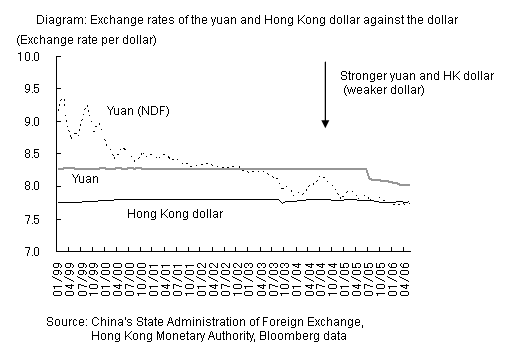Pulled by expectations of the yuan's rise, the Hong Kong dollar has in recent years been exposed to upward pressure in currency markets. Such a situation has remained unchanged even after China revalued the yuan by 2.1% and shifted to a "managed float system" in July 2005. The yuan-dollar exchange rate, which has been rising gradually, is approaching the official Hong Kong dollar-dollar rate of 1 to 7.8, and has already topped that mark in non-deliverable forward (NDF) contracts traded in overseas markets (diagram). Speculation that the Hong Kong dollar will shift from its current dollar peg to a peg of 1 Hong Kong dollar to 1 yuan and rise vis-a-vis the dollar with the yuan is triggering a new round of inflow of funds into Hong Kong.
One reason why the Hong Kong dollar is at the mercy of the yuan's movements is because of the growing perception that with Hong Kong's handover to China in 1997 and the increase in economic exchanges with mainland China, the link between the Hong Kong dollar and the yuan should be strengthened and the two currencies should ultimately be unified. However, authorities are extremely cautious about changing the foreign exchange system and exchange rates because preserving the Hong Kong dollar's autonomy from the yuan is symbolic of the "One Country, Two Systems" agreement that is to be maintained for 50 years after Hong Kong's return to Chinese rule. Furthermore, so long as mainland China’s ability to maintain macroeconomic stability is still in doubt and the convertibility of the yuan in capital transactions is not yet guaranteed, the likelihood of the authorities taking any steps towards unifying the Hong Kong dollar with the yuan is very low, as such a move could harm market confidence in the Hong Kong dollar.
Looking back, Hong Kong moved from a floating to a dollar peg system after the Hong Kong dollar plunged due to the political instability over the handover issue that surfaced in October 1983. Since then, authorities have not condoned a single change to the official exchange rate despite the various shocks experienced by the Hong Kong economy, such as the "Black Monday" in October 1987, the stock market plunge after the Tiananmen Square incident in June 1989, the pullout of funds from emerging markets by institutional investors such as those in the U.S. after the Mexican currency crisis of early 1995, and the Asian currency and financial crisis of 1997-1998 (note). Although the pressure on the Hong Kong dollar this time is not downward, as in the past, but upward, authorities will probably stick to their position of maintaining the dollar peg.
However, in the long term, if ties between Hong Kong and the Chinese economy strengthen further and the international position of the yuan enhances in line with the rise in China’s power, it would be more natural to peg the Hong Kong dollar to the yuan, and finally unify the two. In fact, Mr. Donald Tsang, Hong Kong Special Administrative Region Chief Executive, said for the first time during a radio interview in May this year that on the condition that the yuan’s convertibility is realized, the Hong Kong dollar may be pegged to the yuan instead of the dollar in the future.
Ultimately, the "One Country, Two Currencies" relationship between the Hong Kong dollar and the yuan is only a transitional measure, and there will be no point in making a distinction between the two currencies as convergence progresses in the development stages of the political and economic systems of China and Hong Kong. When drawing up the Sino-British Joint Declaration and the Hong Kong Basic Law that set the framework for Hong Kong's return, authorities seem to have presumed that it would take about 50 years for this convergence to take place. However, if the Chinese economy continues to grow at the pace that it has over the past quarter century, the unification of the two currencies may be realized sooner.



